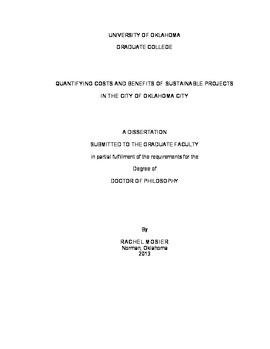| dc.contributor.advisor | Ramseyer, Christopher | |
| dc.contributor.advisor | Gransberg, Douglas | |
| dc.contributor.author | Mosier, Rachel | |
| dc.date.accessioned | 2013-12-11T15:45:37Z | |
| dc.date.available | 2013-12-11T15:45:37Z | |
| dc.date.issued | 2013-12 | |
| dc.identifier.uri | https://hdl.handle.net/11244/7892 | |
| dc.description.abstract | Advocates of sustainable design and construction have asserted for years that sustainability can be designed and built without additional expense, however this premise has not been proven. For public projects, potential accrued savings does not offset budget shortfalls. Design and construction capital costs must be estimated and obtained in an amount sufficient to deliver the entire project, as the funding is often determined years in advance of the project and cannot be changed due to future savings.
Metrics for determining sustainability and the associated costs is provided. A review of the known sustainability benchmarks was performed. For comparison of benchmarks to costs, the percent of sustainability goals that have a cost component have been identified. For each of the five benchmarks approximately half of the credits affect the construction cost.
The research performs both qualitative and quantitative analyses. A Qualitative Comparative Analysis is performed for the case studies. A database was created from the case study projects. Initial costs are used to provide values for sustainable goals.
Quantitative analyses included Net Present Value (NPV), Decision Theory, Analytical Hierarchical Process, Cost Basis and Life Cycle Cost Analysis. Net present value is used to determine pavement preservation type. A carbon footprint cost index illustrates the cost and provides a tangible metric for sustainability. Carbon footprints have been calculated where needed. Frameworks are established as a tool to quantify the cost of sustainability integration in municipal streetscape projects. Decision making tools are provided that allow owners to adjust scope and sustainability while remaining in budget.
Using a cost index for comparison will provide the owner with an easily identifiable difference in the NPV and carbon footprints. This information aids the decision to add sustainable pavement preservation into projects. Since pavement preservation can provide additional life, the additional costs need to be weighed against the benefits. The required features of work are segregated from the proposed preservation options. This allows owners to identify costs of sustainable options to justify additional funding. | en_US |
| dc.language | en_US | en_US |
| dc.subject | Engineering, General. | en_US |
| dc.title | QUANTIFYING COSTS AND BENEFITS OF SUSTAINABLE PROJECTS IN THE CITY OF OKLAHOMA CITY | en_US |
| dc.contributor.committeeMember | McCuen, Tamera | |
| dc.contributor.committeeMember | Zaman, Musharraf | |
| dc.contributor.committeeMember | Volz, Jeffrey | |
| dc.date.manuscript | 2013-12-09 | |
| dc.thesis.degree | Ph.D. | en_US |
| ou.group | College of Engineering::Department of Engineering | |
